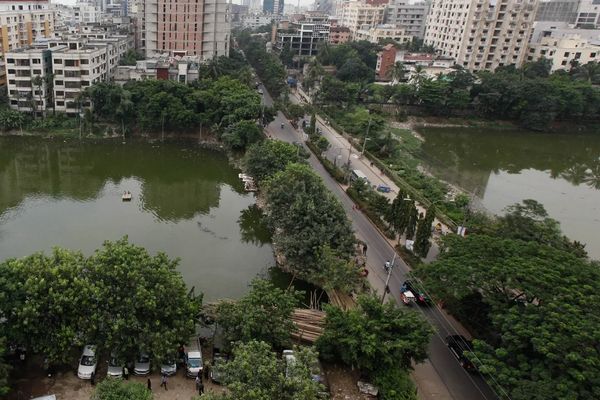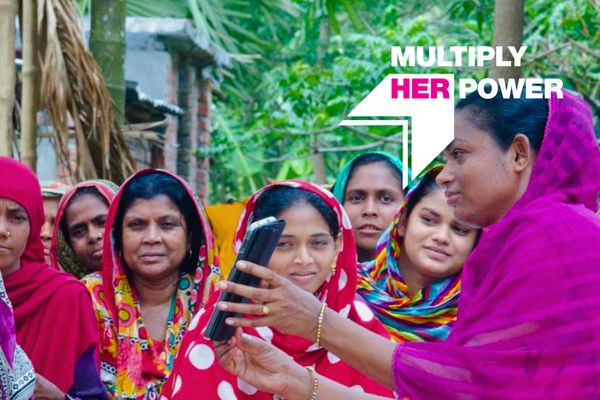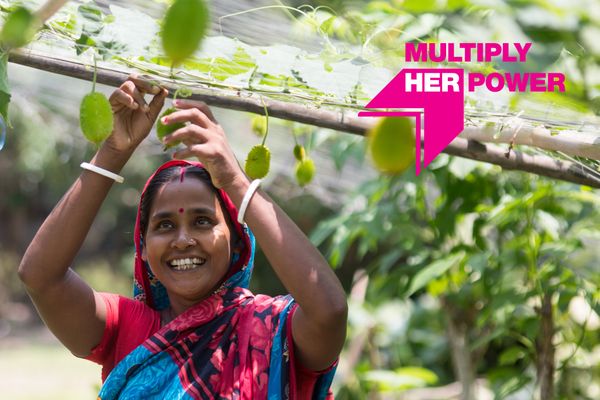This piece was originally published in White Board Magazine. It has been reposted below.
Bangladesh is the home to extraordinary progress in many areas of social development. Not only has this progress benefited people and communities but also insights from it have benefited development across the world. This progress is in peril now, both in the country and across the world, because of the threats of the climate crisis. Meanwhile, Bangladesh has become a leader in climate change advocacy. Its past experience in championing social development can be used to steer large-scale action, this time in climate adaptation.
First, what is climate adaptation?
Climate adaptation refers to the changes in processes, practices and structures needed to moderate damage or grasp opportunities associated with climate change. Adaptation is different from ‘loss and damage,’ which refers to compensation for already-incurred impacts, and mitigation. It aids in decarbonisation efforts to reduce future impacts.
Meanwhile, adaptation can take on many forms. Examples range from building flood defences, to switching to drought-resistant crops, to setting up climate adaptation clinics for farmers, to redesigning cities for climate migrants.
Leading global climate dialogue
Bangladesh has built a strong foundation in global climate discussions. Bangladesh’s prime minister Sheikh Hasina served as Chair of the Climate Vulnerable Forum, the group representing the 48 most vulnerable developing countries, for four years. During her tenure, Bangladesh was instrumental in shifting the narrative from climate vulnerability to climate prosperity. Bangladesh led by example, creating the first climate prosperity plan in 2021 – the Mujib Climate Prosperity Plan – which has since inspired other countries, such as Ghana and Sri Lanka, to develop their own.
On the non-government side, Saleemul Huq, Director of the International Centre for Climate Change and Development in Bangladesh, was listed by the acclaimed multidisciplinary science journal Nature as one of 10 people shaping climate policy in 2022. He was lead author of the third, fourth and fifth assessment reports of the Intergovernmental Panel on Climate Change. He was also recognised as one of the top 20 global influencers on climate change policy in 2019.
On both the government and the non-government sides, Bangladesh is at the forefront of thought leadership on climate change. It now must translate these global advocacy achievements into tangible benefits for the most affected.
The need on the ground is urgent
Climate change-induced events are risking Bangladeshi lives. Torrential rains in 2022 left 3 million people homeless and closed the country’s third largest airport for three days. Around 2.5 million people are struggling with a lack of drinkable water. Salinity has increased by some 26% since the early 1980s. Every day, 2,000 people migrate from coastal areas to the capital city of Dhaka as a result of lost livelihoods. This is just a snapshot of the visible impacts. They will rapidly intensify in both frequency and severity.
How can Bangladesh take inspiration from its strides in social development to tackle the climate crisis?
There is no doubt that Bangladesh has extensive, decades-long, experience in social development. But can this experience be geared towards locally led adaptation on the scale and at the speed that the climate crisis demands? Can it ensure that the benefits of adaptation reach those most affected?
To answer this, we need to revisit Bangladesh’s social development success map. The current elements similar to those in many of the country’s social development successes need to be identified. These elements will now come to smart use. These include the need for collaboration between state and non-state actors; prioritising outcomes; placing young people at the centre of interventions; creating a humanitarian–development nexus on climate; and prioritising lived experience.
Five elements for implementing a climate adaptation strategy
First, close collaboration is needed between the government, civil society and the private sector. This will make it possible to maximise the expertise and capacity of each sector collectively. This has been the key to much of Bangladesh’s extraordinary social progress.
Government at all levels must provide policy direction and crucial networks of infrastructure – physical and socioeconomic. Bangladesh already has strong long-term plans in place, including the Mujib Climate Prosperity Plan, the Perspective Plan 2041 and the Bangladesh Delta Plan 2100. These policy documents ensure a much-needed focus on critical physical infrastructure, such as embankment systems.
To get the full benefit of these policies, the focus should be on delivering services to the most affected people. Non-state actors are well placed to support this, as they already work closely with the communities in the most need. They can facilitate the behaviour change and the social innovation needed for communities to utilise the new infrastructure and services. Meanwhile, the private sector can connect emerging ideas to essential markets. It can bring market-driven efficiencies for sustainability. There is also a key role for foreign development partners in this collaboration, in bringing resources to scale initiatives.\
Collaboration should not just be at the outset of goal-setting and policy-making but throughout implementation and scaling. It should be deliberate and prioritised. The focus should be on the community level, on needs on the ground, gaps in affected communities and the best ideas from the grassroots.
Second, outcomes and the data needed to prove outcomes must be prioritised. Too often, international organisations and governments focus on compliance rather than outcomes. But the urgency of the climate crisis requires that outcomes become the focus. In this connection, research that assesses outcomes and measurement is paramount. For instance, modelling and forecasting systems enable products such as crop insurance, which can raise farmers’ income.
Coordination of data will ensure that comparable data are being properly collected and shared. With proper coordination, digitalised locally collected data can contribute to national databases. The databases can then be used to analyse progress broadly. Such scientific analysis can help in making real-time decisions.
While implementing, stakeholders need to know what works, what doesn’t and how to improve. They need to understand the impact of locally led climate adaptation initiatives. Only then can those that are scalable be identified. The commitment to specific kinds of outcomes needs to be identified in advance by each stakeholder. This will prevent non-governmental organisations from moving without any direction. It will also ensure that everyone is interested in scaling when a project succeeds.
Third, young people need to be engaged in every step of the process. Young people have the most at stake in the climate crisis. Hence, they must be included in decision-making. A powerful example of youth leadership was seen at the 27th Conference of the Parties (COP27), the United Nations’ annual climate talks, in 2022, with Bangladesh being one of the few countries that had included young people in its official delegation. Bangladeshi delegates consisted of youth directly affected by the climate crisis. Their lived experience was a powerful inclusion in the global conference.
Young people can connect the dots between what is happening around them and the climate crisis. As an example, dengue is endemic in Bangladesh, but this last outbreak in 2022 was unusual in its scale and seasonality. Bangladesh experienced moderate rainfall during October 2022, which was later than usual (the monsoon is from May to September). In general, there has been an unusual amount of rainfall since June 2022, accompanied by high temperatures and high humidity. These factors combined have led to an increased mosquito population.
The World Health Organization predicts that the situation is likely to worsen each year now as Bangladesh’s climate becomes more favourable for the transmission of dengue. Other vector-borne diseases, like malaria and chikungunya, will also increase.
There are other climate-induced health impacts. For instance, a study by the icddr,b, a Dhaka-based health research organisation, has found that high blood pressure in coastal areas is 12% more prevalent than the national average. This is because of high salinity in water sources in these coastal regions.
These are just a few less obvious impacts of the climate crisis. Young people need to have the tools to link the climate crisis with the deteriorating quality of life around them. After all, for them, the climate crisis is existential. Young people are savvy enough to reach their counterparts, mobilise and digitalise new initiatives. They can reduce the carbon footprint, through their own actions and by influencing the people around them.
Fourth, we must create a nexus between disaster response and long-term development. While some countries can treat the climate crisis as a future challenge, Bangladesh does not have this luxury: the impacts of the climate crisis are already everyday lived reality. Adaptation needs to combine techniques both from the humanitarian perspective, to respond to the current scenario, and from the development perspective, to prepare for future impacts. We need to be taking both a short- and a long-term view – addressing critical service gaps while enhancing the capacity of communities and working to change systems.
In this context, duplication and mission overlap can also be addressed. Government mandates on climate change and disaster relief, for instance, should be closely coordinated, with a new focus on adaptation. In cases where separate agencies handle climate change and disaster relief, consideration should be given to combining them.
Fifth, priority must be given to the insights from lived experience. The core knowledge of scalable high impact, high return on investment comes from the people closest to the challenges. Consultation with communities must take place before interventions are designed. It should not stop at that. Consultations should also be part of the ongoing process of co-creating, testing, implementing, scaling and measuring impact. The people most affected are best placed to judge whether something is working, particularly in the long term. They see the nuances invisible to people from outside.
No country is better positioned than Bangladesh
Many countries are taking steps to build resilient societies and economies. But bolder ambition is needed. Born the world’s second poorest country, in the aftermath of the world’s deadliest tropical cyclone, Bangladesh has made some of the most extraordinary social development gains since its founding in 1971. It is now time to turn this experience towards the rapidly intensifying climate crisis. This will ensure that Bangladesh’s hard-won development gains are not lost. It is also an opportunity to lead the world.
Both the social and the business case for climate adaptation are strong. In addition to saving millions of lives, adaptation will save billions in disaster response. Research by the Global Commission on Adaptation has found that, for every $1 invested in adaptation, investors could see between $2 and $10 of net economic benefit.
Globally there needs to be dialogue and locally there needs to be action. The world needs a leader to show the climate adaptation way. To take up this challenge, there is truly no country better positioned than Bangladesh.
Cover: An island-boundary between two farms, with white hue salt crusts on it. It is a testament to the saline water intrusion in the climate vulnerable Khulna region, southwestern Bangladesh, 2014 | Photo by MN Chowdhury/ BRAC.
Photo ©️ Mahmud Hossain Opu
Saber Chowdhury is a member of parliament in Bangladesh and Chair of the Parliamentary Committee on the Ministry of Environment, Forest and Climate Change. He is a politician and an entrepreneur. He was Bangladesh’s Deputy Minister of the Ministry of Shipping and the Ministry of Local Government, Rural Development & Cooperatives. He was President of the Inter-Parliamentary Union and Chair of the Asian Advisory Group of Parliamentarians for Disaster Risk Reduction and Global Champion of the United Nations Office on Disaster Risk Reduction. He pursued his graduate studies at the School of Oriental and African Studies, University of London.
Asif Saleh is the Executive Director of BRAC. He is a writer, technologist and a social entrepreneur. He was a policy specialist for the Access to Information (A2i) Program at the Prime Minister’s Office of Bangladesh. He was the Executive Director at Goldman Sachs and also worked for IBM, Glaxo Wellcome and Nortel. He is a Asia 21 Fellow of Asia Society and a Young Global Leader of World Economic Forum. He pursued his undergraduate studies from Stern School of Business at New York University.



